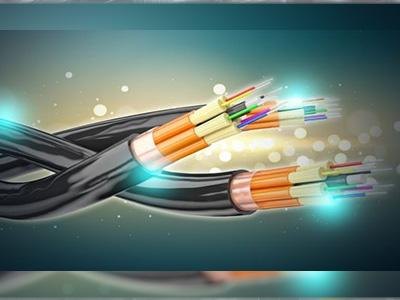Fiber Optic Technology and How it Works

I. Introduction
Fiber optic technology has transformed the telecommunications industry over the past few decades. This blog post will provide an overview of what exactly fiber optics are and how they work to transmit information using light signals. We’ll also explore the different types of fiber optic cables, components, advantages, and applications.
II. How Fiber Optics Work
The modern world runs on data. Every text, email, social media post, and cat video travels immense distances in the blink of an eye thanks to fiber optic cables - thin strands of glass that use light to transmit information. This article will shed light on how fiber optics illuminate our data infrastructure.
At the heart of a fiber optic cable lies an inner glass core. This core is an extremely pure optical material surrounded by a cladding of lower refractive index. When light enters the core, rather than escaping out the sides, it bounces off the cladding in a process called total internal reflection. This keeps the light contained within the core over long distances.
To understand this, picture a mirror tunnel that reflects a flashlight beam down its length. Similarly, fiber optic cables use internal reflection to guide light. The difference in refractive index between the core and cladding facilitates this reflection based on the principles of Snell's Law.
Light sources such as LEDs and laser diodes convert electrical inputs into optical outputs. Their light shines into the opening of the fiber optic core. At the other end of the cable, photodetectors receive and convert the light back into electrical signals. These input and output processes allow fiber optics to interface with electronic devices.
So how does light transmit data? By modulating properties like intensity, color, and blink patterns, light waves can encode any information. For example, a faster blink rate equates to a 1 compared to a slower 0 blink. Billions of variable light pulses per second translate into astonishing bandwidth.
There are two types of fiber optic cables. Multi-mode fibers have larger 50-100 micron cores that support multiple light paths. This enables high data rates over shorter network distances. Single-mode fibers with 10 micron cores maintain a single transmission path, providing greater range up to miles.
From backbone networks spanning continents to HD endoscope imaging of internal tissues, fiber optics underpin our information society. Their advantages over fragile copper wiring include no electromagnetic interference, higher speeds, lower latencies, and vast room for growth.
While electrons flowing through copper dissipate over distances, photons of light persist much further before needing a boost from optical amplifiers. This enables unrivaled capacities with little signal degradation.
The journey of our data begins as flickering electrical impulses within devices. Optical fibers provide a pristine conduit for data transmission between locations distant and micro. Without these slim glass strands transmitting light, the Internet and telecom networks would go dark. Next time you surf the web or make a call, take a moment to appreciate fiber optics magically moving data at light speed.
III. Types of Fiber Optic Cables
There are two main categories of fiber optic cables:
Single-mode fiber has a small core (about 10 micrometers) and can only transmit a single ray of light. This allows it to travel longer distances while maintaining higher bandwidth. It is typically used for telephony and Internet infrastructure.
Multi-mode fiber has a larger core (50-100 micrometers) and can transmit multiple light rays simultaneously. This results in higher light loss over longer distances but allows more data transmission over shorter distances. Multi-mode fiber is often used for short-distance connections and LAN networks.
Plenum: Plenum-rated fiber optic cables are designed for safe installation in building air plenums. They have low smoke and flame characteristics to meet strict fire safety codes, making them suitable for indoor environments like data centers.
Simplex And Duplex Optical Fiber: Simplex fiber cables consist of a single strand, ideal for one-way communication. Duplex fiber cables include two strands, facilitating two-way communication in applications such as network connections.
Pre-terminated Fiber Optic Assembly: Pre-terminated assemblies are factory-made optical cables with connectors installed, saving installation time and minimizing errors. They are versatile and commonly used in data centers and telecommunications installations.
IV. Key Fiber Optic Components
On each end of a fiber optic cable, light signals must be converted to/from electrical signals. Key components include:
Transmitters: Transmitters convert electrical signals to optical output using LEDs or laser diodes, enabling data transmission through fiber optic cables with precision and speed.
Receivers: Receivers transform incoming optical signals into electrical outputs using photodiodes, making it possible to process data transmitted through fiber optic communication systems.
Connectors: Fiber optic connectors like FC, SC, LC, and ST types securely join optical cables while minimizing signal loss, ensuring reliable data transmission in various applications.
Amplifiers: Optical amplifiers enhance attenuated light signals over long distances in fiber optic systems, allowing data to travel further without signal degradation, while electrical amplifiers convert light signals back to the electrical domain.
V. Advantages of Fiber Optics
Higher Bandwidth: Fiber optics can transmit data at incredible speeds, with the capability to carry over 50 terabits per second, far surpassing the capacity of traditional copper wires.
Less Transmission Loss: Light experiences significantly less signal strength loss over distance compared to electrical signals, allowing for long-distance data transmission without significant degradation.
Immunity to Electromagnetic Interference: Fiber optics are impervious to electromagnetic interference, ensuring reliable communication even in environments with high electromagnetic fields.
Harder to Tap: The light signals in fiber optics are contained within the cable, making it exceptionally challenging for unauthorized parties to intercept or tap into the transmitted data.
VI. Applications of Fiber Optics
Because of these advantages, fiber optic technology has become ubiquitous in telecommunications networks. Key uses include:
Long Distance Telephone Networks: Fiber optics underpin long-distance telephone networks, enabling high-speed data transmission over vast distances with minimal signal degradation.
High-Speed Internet Backbone Connections: Fiber optics serve as the backbone of high-speed Internet connections, facilitating rapid data transfer for countless users.
Local Area Networks (LANs): Fiber optics are used in LANs to provide high-speed and reliable data connections within businesses and institutions.
Medical Imaging Tools like Endoscopes: Fiber optics play a crucial role in endoscopes, enabling physicians to visualize internal organs with precision and minimal invasiveness.
High-Precision Sensors: Fiber optic sensors are used in a wide range of applications, providing accurate data in industries such as manufacturing, civil engineering, and environmental monitoring.
Military/Aerospace Applications: Fiber optics are employed in military and aerospace technologies for secure and high-speed data communication, along with sensing and control systems.
In conclusion, fiber optic technology has revolutionized telecommunications and data transmission by harnessing the power of light to convey information. With a variety of fiber optic cables, components, and the advantages they offer, this technology has found its place in numerous applications, from long-distance telephone networks to high-speed internet connections, medical imaging, and precision sensors. Its immunity to electromagnetic interference and heightened security make it a versatile choice.
- (This "Security Blogs" Published in February 2024 Edition)












